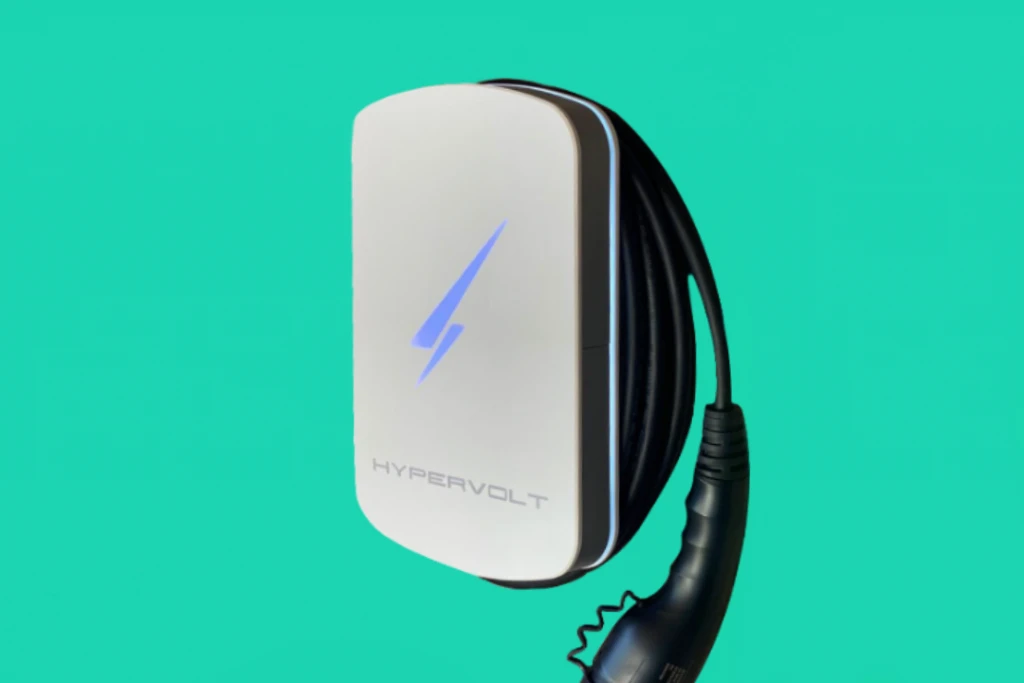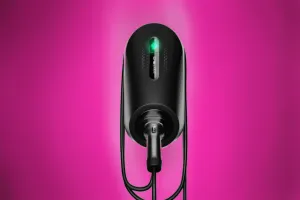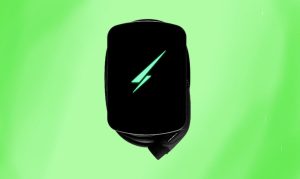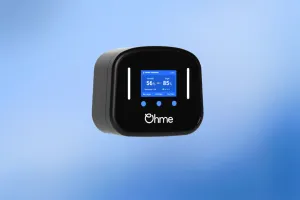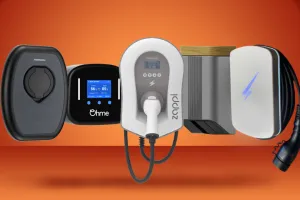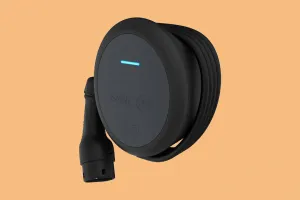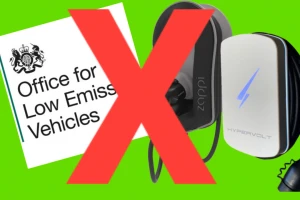The home 3.0 is an EV charger from UK-based company Hypervolt. Having received backing from Innovate UK, the Government-backed innovation and research agency, this new charger looks to make its mark on the home charging scene.
This EV charger aims to bring premium features at an affordable price, and at the same time offer style and ease of use.
PLEASE NOTE: A new redesigned Hypervolt is now available. Please read our review of the Hypervolt Home 3.0 Pro here.
Hypervolt overview
The Hypervolt home 3.0 is a wall-mounted EV charger with a 5m tethered lead, available in both type 1 and 2 variants. The tethered lead is wrapped around the Hypervolt unit quite discretely with the ability to stow the connector in a wall-mounted holster (included).
The Hypervolt is constructed from ABS composite and is extremely durable in all weather conditions with an IP54 rating. Charging at the standard 7kW (32A at 230v) with options to reduce this in-app, or using the new automatic load management feature.
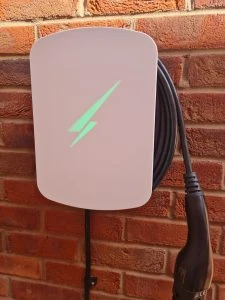
Hypervolt in ultrawhite
Hypervolt dimensions
The Hypervolt EV charger measures 328mm x 243mm x 101mm. This is smaller than chargers such as the Andersen A1 and Myenergi Zappi. The depth is only 101mm makes the Hypervolt quite slimline in comparison with most chargers.
What’s in the box?
The Hypervolt home 3.0 charger.
CT Clamp
Cable holster
Installation mounting plate (now cardboard)
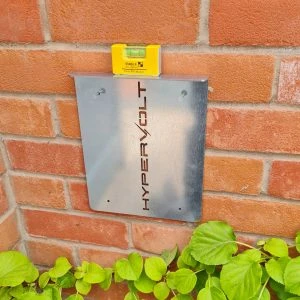
Metal installer mounting plate for approved installers easy marking of fixings during installation
Hypervolt features
PEN fault detection
Not the first feature most people look for but it is an important one as it’s there for safety.
Early EV chargers and chargers in the cheaper price bracket require an earth rod to be installed. This offers added protection in case of a fault on the property’s supply cable. If there is a fault on the supply cable coming into the property in some circumstances the metalwork of the car may become live, this can be potentially fatal if anyone was to touch this.
The downside to the earth rods is they can be time-consuming to install and also look really unsightly on the front of a property. This is where PEN fault detection comes into play as it constantly monitors the incoming supply. In the event of a supply fault, the Hypervolt will stop charging preventing potential harm. This feature comes as standard on the Hypervolt meaning a simple installation every time.
Automatic load management
Again another important safety feature as it prevents overload of your electrical supply. The Hypervolt is set to a limit that matches the size of the main incoming supply fuse, it then monitors electricity usage in the home and alters the charge rate to the EV to suit.
For instance, if the limit is set to 60A and 40A is used in the home elsewhere then charging to the EV will drop to 20A. This keeps the maximum demand to 60A and prevents the main fuse from blowing and limits the chance of a total loss of power. What’s great is that there is a visible representation of this happening on the front of the Hypervolt unit as the LED logo fades out to represent lower power which is a neat little touch.
Monitoring of the main fuse is done via a CT clamp which is clipped to the supply cables at the electric meter.
The CT clamp is hard-wired to the Hypervolt via a separate cable or a combined power and data cable like Doncaster Cables EV Ultra can be used. This makes installation more aesthetically pleasing as only a single cable is used.
Unfortunately, wireless CT clamps aren’t currently available, unlike the Myenergi Zappi.
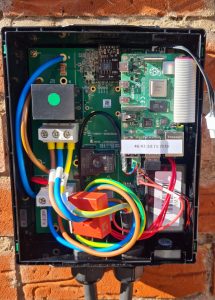
Internal view of Hypervolt with Rasberry Pi computer inside
RCD protection
The Hypervolt has 6mA DC protection built-in therefore an expensive external B-type RCD is not required making installation straightforward.
An A-type RCD or RCBO is required at the consumer unit though. This can be installed in an existing consumer unit (if available) or within a separate enclosure nearby.
Microgeneration compatibility
The Hypervolt now offers 3 modes of solar charging, similar to the Zappi. This helps optimise the use of home-generated electricity and prevent surplus energy from being sent to the grid..
Setting the Hypervolt to ‘boost’ mode the EV will be charged at the full rate up to 7kW. This will use any solar-generated energy, and then top up the remainder from the grid to ensure a full 7kW charge. If no solar energy is generated the Hypervolt will charge at 7kW from grid electricity.
In ‘eco’ mode the Hypervolt will use the minimum amount of grid-supplied electricity as possible to ensure the Hypervolt charges the EV at the 1.4kW required. If the solar array generates more than 1.4kW then no grid energy will be used.
The 3rd mode is ‘super eco’, in this mode, the Hypervolt will only charge via solar energy. For this to work 1.4kW of surplus energy is required to begin charging, if this is not reached the Hypervolt will not charge the EV.
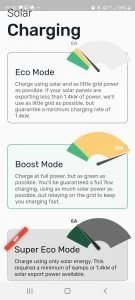
These modes are easily changed by using the Hypervolt app.
Monitoring of the solar is done via the bi-directional CT clamp installed at the meter.
Hypervolt Connectivity
The Hypervolt also uses WiFi for automatic over-the-air firmware updates to ensure things are kept up to date.
Hypervolt App
The Hypervolt app gives full control of charging modes and the ability to view energy consumption. This is available from Apple and Google app stores by searching ‘Hypervolt’
Setting up the app is really straightforward. Your smartphone connects to the Hypervolt via Bluetooth to adopt the unit. Once adopted it’s just a case of selecting your WiFi SSID from a list and entering the password. It literally takes one minute!
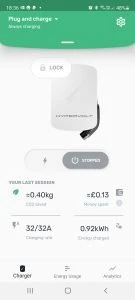
App Features
The Hypervolt app has a really simple interface, especially when setting charging schedules. Multiple sessions can be timed to coincide with your cheap rate electricity tariff such as Octopus’s Go EV charging tariff. Alternatively, a ‘plug and charge’ mode can be set.

Analytics of energy consumption in kWhs or British pounds can be displayed. Tariff rates are adjustable so they can be set to match your energy provider rate.
These analytics are downloadable from the dashboard when using a desktop/laptop to sign in to your account., This is really useful for users who need to claim back expenses through their business.
The Hypervolt can also be set to lock mode to prevent unauthorised use. Hypervolt LED will be orange to indicate that lock mode is enabled.
Smart EV charging regulations compatible
Alexa integration
Hypervolt is one of the only chargers that has full Alexa integration. Voice commands can be used to switch on charging, dim the LED panel and set charging schedules. Ask Alexa to “ask Hypervolt to get the party started” and you will be treated to a multicolour light show.
Styling options and extras
The Hypervolt is available in 3 colours, ultrawhite, ultrablack and space grey.
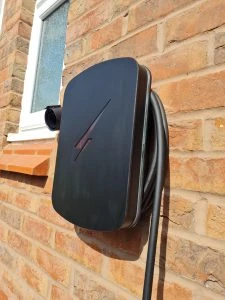
Ultrablack Hypervolt
The unit itself has a nice clean modern look to it with a matt finish.
There is an LED panel on the front of the unit which illuminates different colours depending on the charging mode. When waiting in standby it’s blue and then changes to green when an EV is plugged in and charging.
If a scheduled charge has been set the Hypervolt will glow purple indicating it’s waiting for the charging programme to begin.
If the LED light is too bright it can be dimmed or switched off via the app.
There is a 5-metre tethered lead as standard which can be upgraded to 7.5 or 10 metres if required.
The standard 3-year Warranty can also be upgraded to 5 years for extra peace of mind (£100 additional cost)
Hypervolt also has a mounting post available if you require installation remote from your property. This is in conjunction with EV Tower who make posts for many other EV chargers. The post is priced at £288.
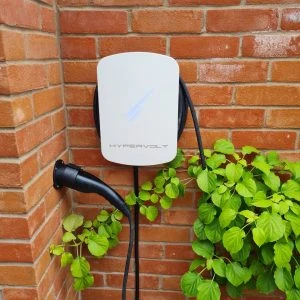
Hypervolt and cable holster installed
Hypervolt Pricing
The Hypervolt has been reduced in price and now priced at £660(including VAT) for the 5m model -previously £679.
The 7.5m model is priced at £702 and the 10m at £759.
Installation costs will vary. Costs depend on various factors including the distance from your consumer unit and the compatibility of your existing electrical installation ( consumer unit/earthing etc).

Hypervolt in Spacegrey
Verdict
The Hypervolt is a great entry to the EV charger market, it will please both installers with its ease of installation and users with its styling and simplicity.
Priced considerably less than other premium chargers the Hypervolt is a great alternative to the Myenergi Zappi. With its ease of use and many features, the Hypervolt should definitely be near the top of your list of potential chargers to have.
Not only is the charger great but Hypervolt as a company is a pleasure to deal with. Their technical support helpline is open until 7pm on weekdays and also open at the weekend. In the event that they haven’t taken my call they usually ring bang soon afterwards. This fast service is lacking with some other manufacturers.
Technical assistance is also available via Whatsapp.
As an installer, the only issues I’ve encountered with the unit are mainly WiFi connection issues, but this is the same with most EV charger points as Wifi signals do not pass through exterior walls very well. I would always recommend using a wired connection where possible with any charge point or failing that a Wifi extender installed as near to the chargepoint as possible.
We recommend testing the signal at the install location using an app like Ubiquitis WiFiman to check signal is below -65dbm for a reliable connection.
Installation
If you are based within Shropshire or Wrexham areas and you wish to have a Hypervolt installed then please get in touch here.
For anyone else then contact Hypervolt to find your local approved installer.
PLEASE NOTE: Ian Leech Electrical Contractor Limited has not been paid by Hypervolt in any way for this review. We are totally independent and the review is our honest opinion.
We do install Hypervolt products but this is because we believe in their product and them as a company.

